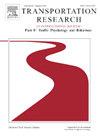When what’s on the outside counts: Protective motorcycle apparel
IF 3.5
2区 工程技术
Q1 PSYCHOLOGY, APPLIED
Transportation Research Part F-Traffic Psychology and Behaviour
Pub Date : 2025-02-01
DOI:10.1016/j.trf.2024.12.033
引用次数: 0
Abstract
The present study aims to investigate the intention to use non-mandatory protective motorcycle apparel in a sample of Australian motorcycle riders. Past research indicates that not all motorcyclists wear non-mandatory protective apparel on every ride. Given the efficacy of protective motorcycle apparel to reduce the severity of injuries and likelihood of fatality, it is important to understand the factors contributing to usage rates. The present study applied the Theory of Planned Behaviour to examine the factors driving and impeding use of mandatory and non-mandatory protective motorcycle apparel. Participants were 398 licenced motorcycle riders (80.9% male, 18.8% female, 0.3% other) who took part in an online survey assessing licence status, riding experience, primary reason for riding, returning rider status, protective motorcycle apparel use on their most recent ride, and all Theory of Planned Behaviour constructs (i.e., attitudes, subjective norms, perceived behavioural control, and intentions to wear protective motorcycle apparel), including the extended constructs of descriptive norms and anticipated regret. Overall, the results showed that the majority of riders in every age category wore a full faced helmet, motorcycle-specific top, gloves, boots, and impact protectors on their most recent ride. The results indicated that both the original and extended Theory of Planned Behaviour constructs were positively associated with intention to use protective motorcycle apparel. The present study provides preliminary evidence to suggest that the efforts by industry stakeholders to improve non-mandated protective motorcycle apparel use by Queensland motorcyclists have been efficacious..
求助全文
约1分钟内获得全文
求助全文
来源期刊
CiteScore
7.60
自引率
14.60%
发文量
239
审稿时长
71 days
期刊介绍:
Transportation Research Part F: Traffic Psychology and Behaviour focuses on the behavioural and psychological aspects of traffic and transport. The aim of the journal is to enhance theory development, improve the quality of empirical studies and to stimulate the application of research findings in practice. TRF provides a focus and a means of communication for the considerable amount of research activities that are now being carried out in this field. The journal provides a forum for transportation researchers, psychologists, ergonomists, engineers and policy-makers with an interest in traffic and transport psychology.

 求助内容:
求助内容: 应助结果提醒方式:
应助结果提醒方式:


